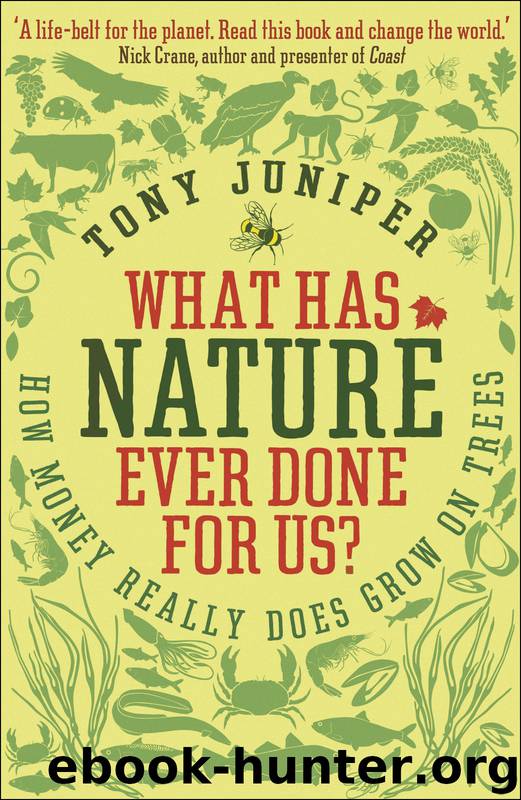What Has Nature Ever Done For Us? by Tony Juniper

Author:Tony Juniper
Language: eng
Format: epub
Publisher: Profile
Published: 2013-01-26T16:00:00+00:00
One third of 1 per cent
This chain of events and causes and effects is of course far from unique. Across the globe our impact on fresh water only grows. Rising demand for the life liquid comes from pressure to grow more food, more affluent lifestyles and the water-using devices that come with them, industrial expansion and population growth. All are adding to a rising burden that will cause serious stresses and strains in the years ahead. While travelling along great rivers like the Magdalena can give the impression that fresh water is super-abundant, this is I fear another of those feelings that is not as accurate as we might like to think.
There are about 1.4 billion cubic kilometres of water on Earth. It is thought that most of it arrived in comets that collided with the young planet about 4 billion years ago. Since then it has been endlessly recycled. From clouds to rain to rivers to ocean to clouds to rain to rivers to oceans, it sometimes gets locked in ice and in more recent times sometimes it passes through plants and animals – the endless cycle which replenishes freshwater sustains all the life on land. But the proportion that is in the liquid freshwater state, the water that is so vital for us, is just a tiny sliver of the total.
If it were possible to gather together all the water on Earth, all the seas, lakes, rivers, ice, clouds and groundwater, and to make it into a spherical aqueous blob, it would sit over an area about the size of Eastern Europe. I sometimes use a pictorial representation of exactly this in lectures. I am always struck by how it seems that the little blob of water would barely moisten the great dry rock (the Earth) that it is juxtaposed with. What I find even more striking is how that blob is divided up.
Nearly all of it is ocean, and therefore salt water – a full 97.5 per cent is in this state. Of the remaining 2.5 per cent that is fresh water about two-thirds is locked up in the ice caps and glaciers. Nearly all of the remaining third is underground in the rocks, leaving only one third of 1 per cent of the fresh water on the planet in rivers, lakes, streams, clouds and rain. This vanishingly thin proportion of the total water, augmented with groundwater, is what keeps the global economy going, and sustains all of the variety of life found on land. It is as fundamental for our continuing existence as the air we breathe.
Hardly less significant is the fact that water simultaneously occurs on our planet in three distinct states: ice, liquid and vapour. All three are vital for the functioning of the Earth system. Ice caps, among other things, reflect back solar radiation and keep the Earth cooler than it would otherwise be. Glaciers on high mountains are the source of summer river flow, including through the massive rivers that supply much of the water needed to keep afloat the economies of the two most populous countries on Earth.
Download
This site does not store any files on its server. We only index and link to content provided by other sites. Please contact the content providers to delete copyright contents if any and email us, we'll remove relevant links or contents immediately.
| Accounting | Economics |
| Exports & Imports | Foreign Exchange |
| Global Marketing | Globalization |
| Islamic Banking & Finance |
The Meaning of the Library by unknow(2505)
Six Billion Shoppers by Porter Erisman(2268)
Why Nations Fail: The Origins of Power, Prosperity, and Poverty by Daron Acemoglu & James Robinson(2235)
No Time to Say Goodbye(2058)
Red Notice by Bill Browder(2026)
The Economist [T6, 22 Thg9 2017] by The Economist(1890)
Currency Trading For Dummies by Brian Dolan(1881)
Thank You for Being Late by Thomas L. Friedman(1739)
Bitcoin: The Ultimate Guide to the World of Bitcoin, Bitcoin Mining, Bitcoin Investing, Blockchain Technology, Cryptocurrency (2nd Edition) by Ikuya Takashima(1666)
Amazon FBA: Amazon FBA Blackbook: Everything You Need To Know to Start Your Amazon Business Empire (Amazon Empire, FBA Mastery) by John Fisher(1541)
Coffee: From Bean to Barista by Robert W. Thurston(1488)
The Future Is Asian by Parag Khanna(1437)
The Great Economists by Linda Yueh(1432)
Pocket World in Figures 2018 by The Economist(1388)
How Money Got Free: Bitcoin and the Fight for the Future of Finance by Brian Patrick Eha(1385)
Grave New World by Stephen D. King(1384)
Capitalism Without Capital: The Rise of the Intangible Economy by Jonathan Haskel(1375)
The Sex Business by Economist(1344)
Cultural Intelligence by David C. Thomas(1263)
